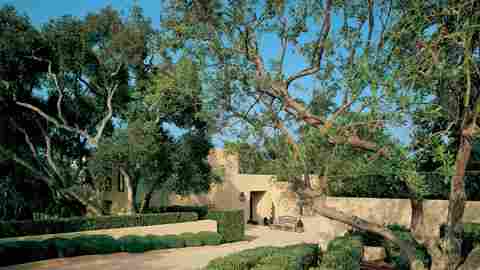Bruce Gregga
View Slideshow

Ever since the years when it served as a playground for old-time Hollywood royalty like Charlie Chaplin and Ronald Colman, Montecito has drawn those looking for the good life, California style. With its palmy beach, fine homes and winding hillside lanes that smell of eucalyptus, this enclave near Santa Barbara has an air of easy sophistication. Here, a Mediterranean-style villa draped in bougainvillea remains the residential ne plus ultra for most people, though not for Bruce Gregga.
"I've described my place to friends as a penthouse on a hill," Gregga says of the contemporary residence that he shares with his partner, William Laman, and that he has decorated with his collection of 18th- and 19th-century antiques and 20th-century art. Gregga's allusion to an urban high-rise isn't surprising. A prolific interior designer whose work has ranged from a Grosvenor Square apartment to a Kona coast home to a Dutch-built yacht (see Architectural Digest, January 1996), he had a practice based in Chicago for nearly four decades before he made the permanent move to Montecito two years ago.
The comparison of his home to a penthouse is curiously apt. With the house surrounded by terraces, there are moments when you feel you might just be at the top of a skyscraper. When you're seated in the living room, with a low terrace wall partially blocking the closer view of trees and the green fairways of a nearby golf course, the primary view is of sky and the looming Santa Ynez Mountains.
Built in 1992 on a sloping site facing the mountains, the 5,300-square-foot stucco house, designed by Paul Gray, is essentially a grouping of architectural boxes. "This place had what I was looking for," says Gregga, who purchased the three-bedroom residence in 1998. "There's an open, free feeling, with high ceilings, privacy, a lot of natural light from windows and skylights and a magical view of the mountains." The fact that the architecture worked as a clean background for his collections was also important.
A recurrent theme in Gregga's work has been the use of contemporary settings for antique furniture, as well as the reverse—decorating very traditional spaces with modern furnishings and art. "I like the contrast between a background and the elements you place in it," he says. At his own residence, Gregga accentuated architectural simplicity with cosmetic changes, such as walling over several windows, extending the oak floors throughout the house and using a soft vellum color on all walls and ceilings. His judicious placement of often ornate objects into this neutral shell serves to heighten their dramatic effect, whether the object in question is an 18th-century French commode with ormolu mounts or an edgy and dark abstract painting. "It's important to take a space and give it air," says Gregga. "You have to make sure there aren't so many objects crowded into a room that they lose the beauty of their form."
This principle is most evident in the living and dining rooms. In the living room, Gregga has given enough space to a voluptuous 19th-century French center table of glowing fruitwoods and satinwood for its form to sing, while the curve and swoop of an eagle's wings on an 18th-century Continental carved oak stand appear in striking silhouette against the wall. Even the smaller objects, like an intriguing 20th-century African mask atop an old Chinese black-lacquered desk, are able to make a little splash. And the only competition for the show inside is the ever-changing view of light on the mountains visible through the wall of sliding glass doors.
You find the same openness in the entrance hall, home to a grouping of 1920s Russian avant-garde art that includes a painted-wood-and-metal construction by Vasilij Ermilov. ("I had to have it as soon as I saw it in a Paris gallery," confesses Gregga.) Washed in natural light from a series of skylights, the hallway is a surprise for most visitors. "The front courtyard is very spare and clean," Gregga says, "with shrubs clipped into geometric shapes and no windows to interfere with the rectangular shapes of the house. There's no clue that when you come through the front door, you'll be in such a light-filled space."
Gregga has made the bedrooms denser, softer environments to convey a feeling of enveloping comfort. In the master bedroom, an oil painting of a languid, reclining female, attributed to Whistler, hangs above a bed upholstered in cloudlike white matelassé. Equally inviting is the bed in the guest room, a late-18th-century mahogany tester outfitted with miles of blue-and-white batik fabric and flanked by 18th-century French avian and botanical drawings.
The garden, which descends the hillside in three terraces, required a complete transformation to conform to Gregga's vision. He turned to landscape architect Sydney Baumgartner, who removed many plantings next to the house while opening up views and screening the residence for more privacy. The overgrown area around the pool was pared to the bone, and a few select objects—including a 19th-century terra-cotta roof adornment from Yogyakarta, Indonesia—were introduced. "I've always admired how Bruce's interiors give interesting or beautiful objects the space to let their integrity shine," says Baumgartner. "And that's the same principle I helped him extend into the garden."
Late afternoon is Bruce Gregga's favorite time of day at his penthouse on a hill. At sunset, he and Laman can often be found on the poolside terrace, looking across lush fairways to the Santa Ynez Mountains. "There's a wonderful cross light that creates deep shadows in the crevices of the mountains and long shadow lines of trees on the golf course," says Gregga. "It's a deeply tranquil time, and a good reminder of why I live here."